
LOADING ...
In response to evolving domestic opinion, eMedals Inc has made the conscious decision to remove the presentation of German Third Reich historical artifacts from our online catalogue. For three decades, eMedals Inc has made an effort to preserve history in all its forms. As historians and researchers, we have managed sensitive articles and materials with the greatest of care and respect for their past and present social context. We acknowledge the growing sentiments put forth by the Canadian public and have taken proactive actions to address this opinion.
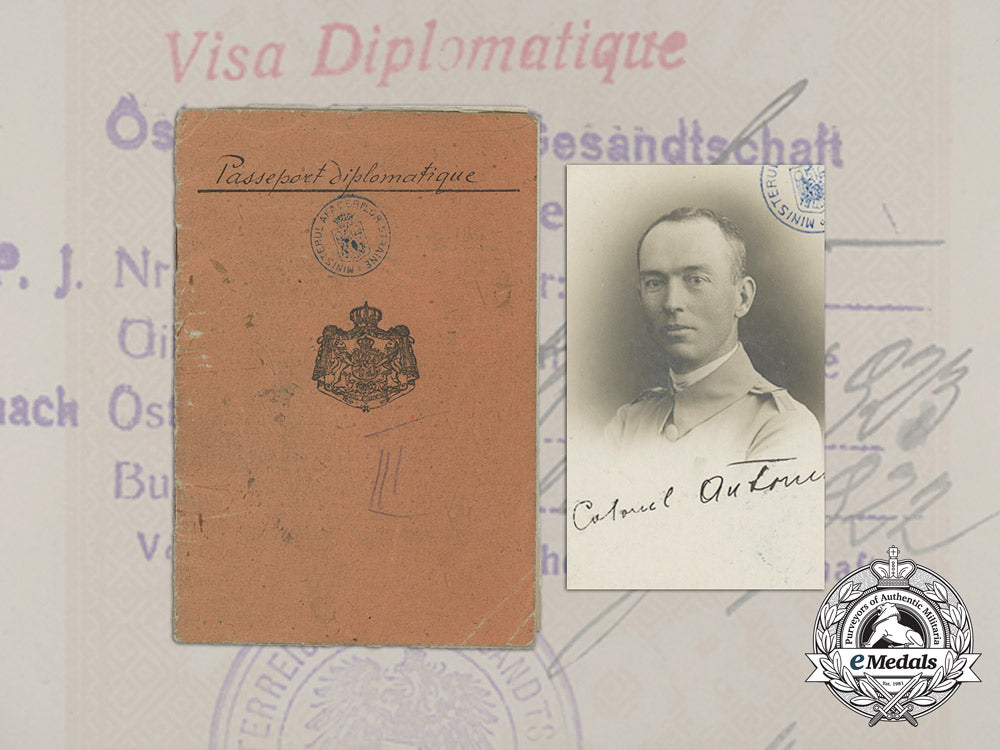
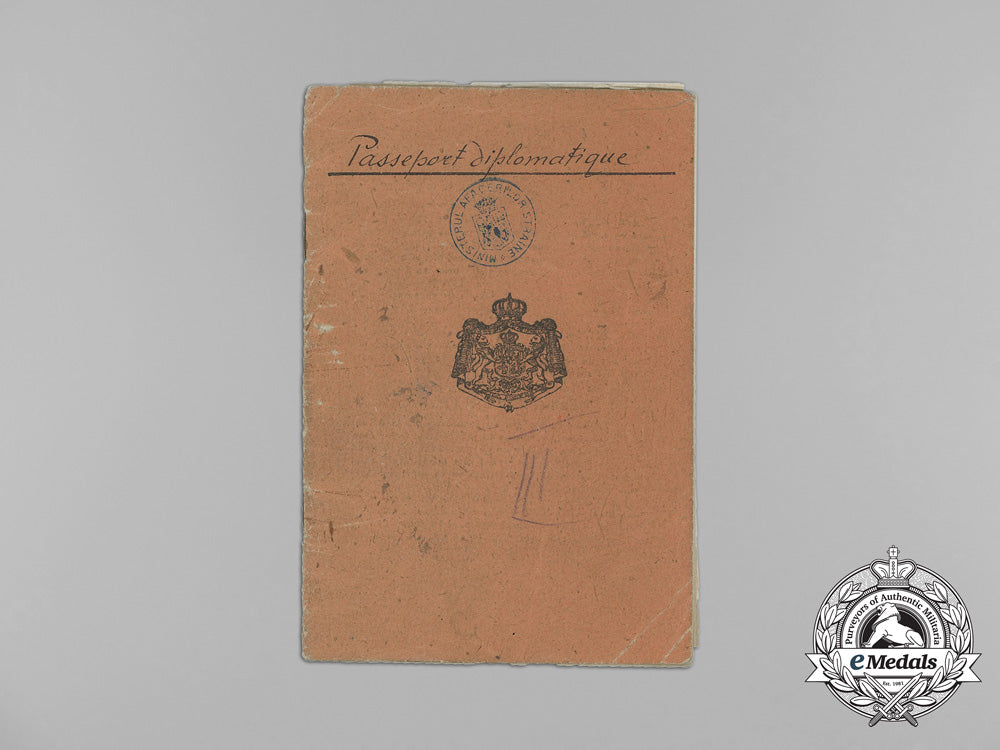

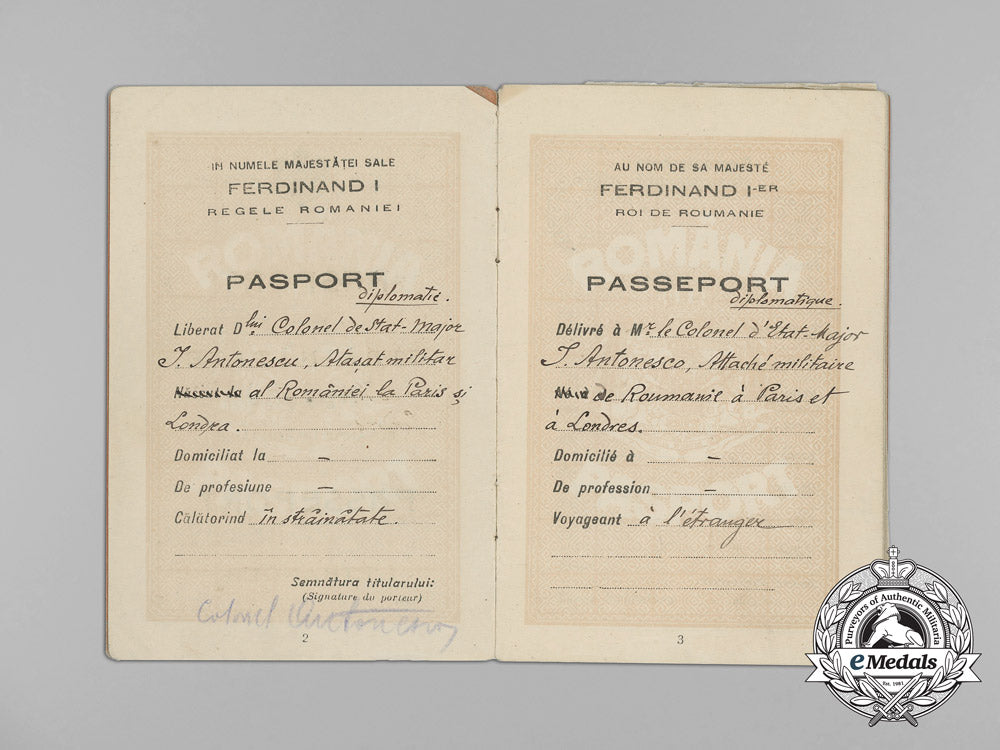
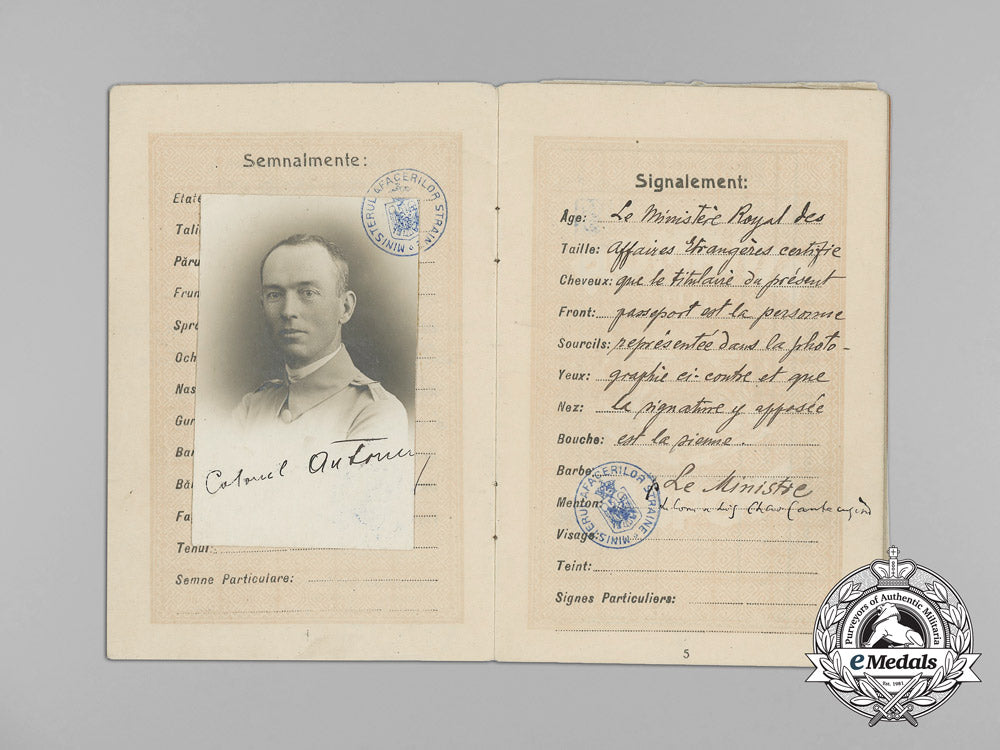
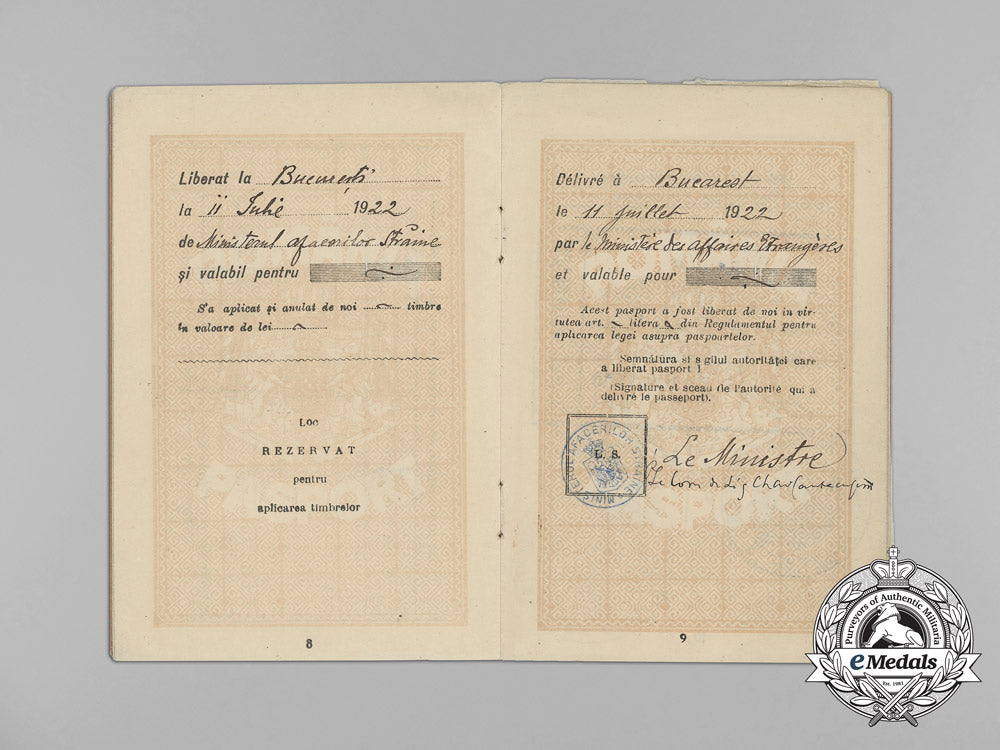
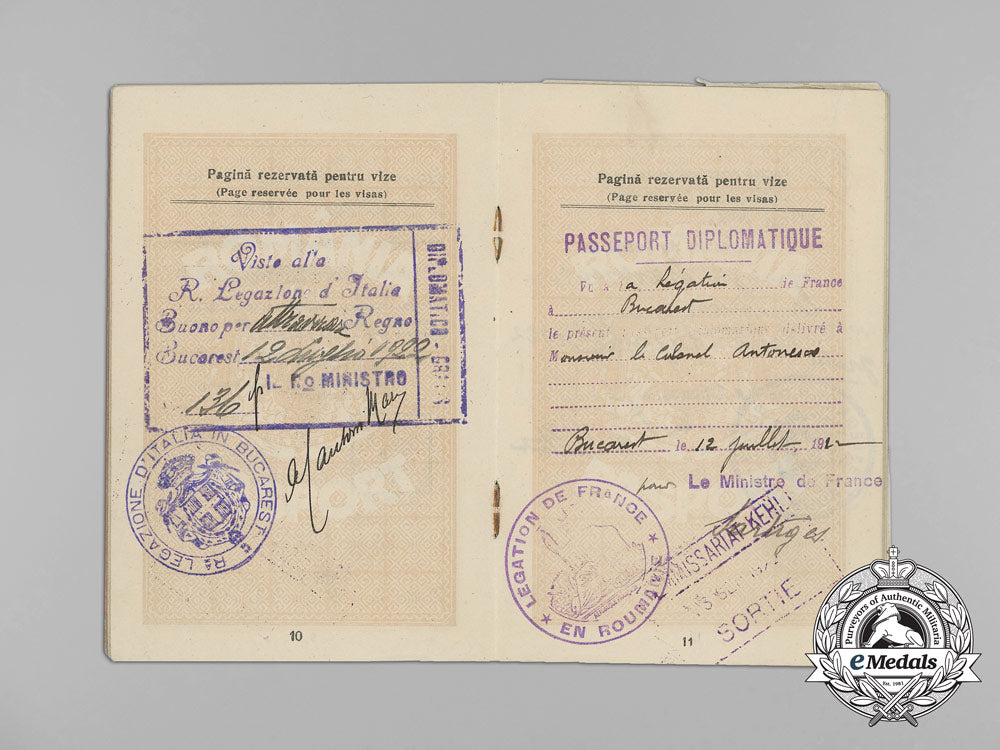

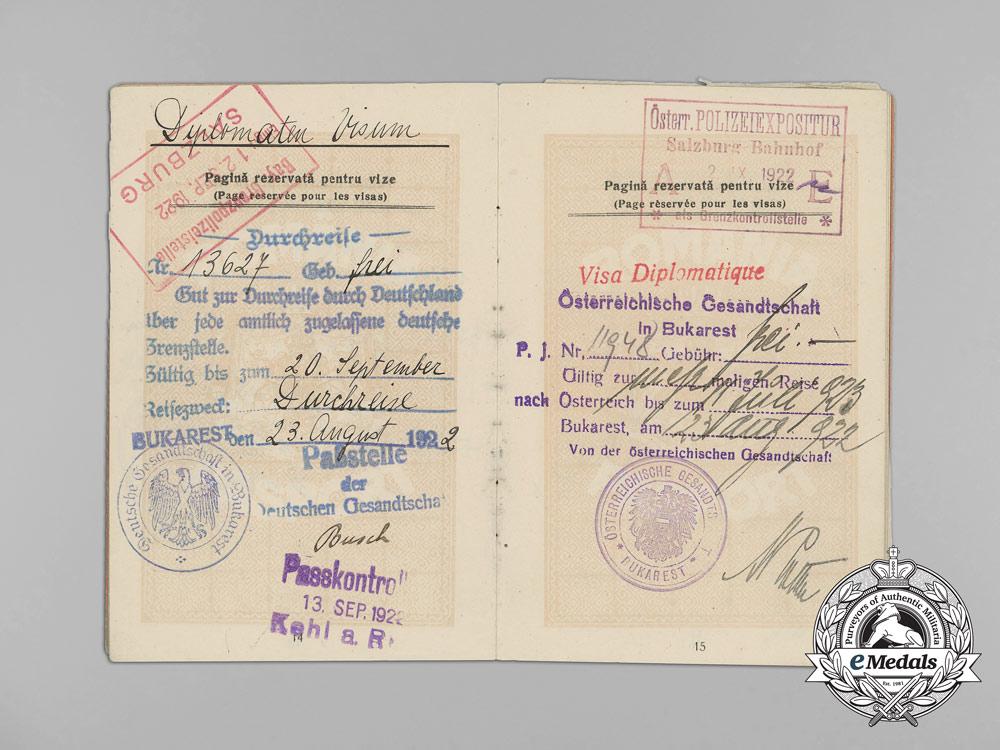
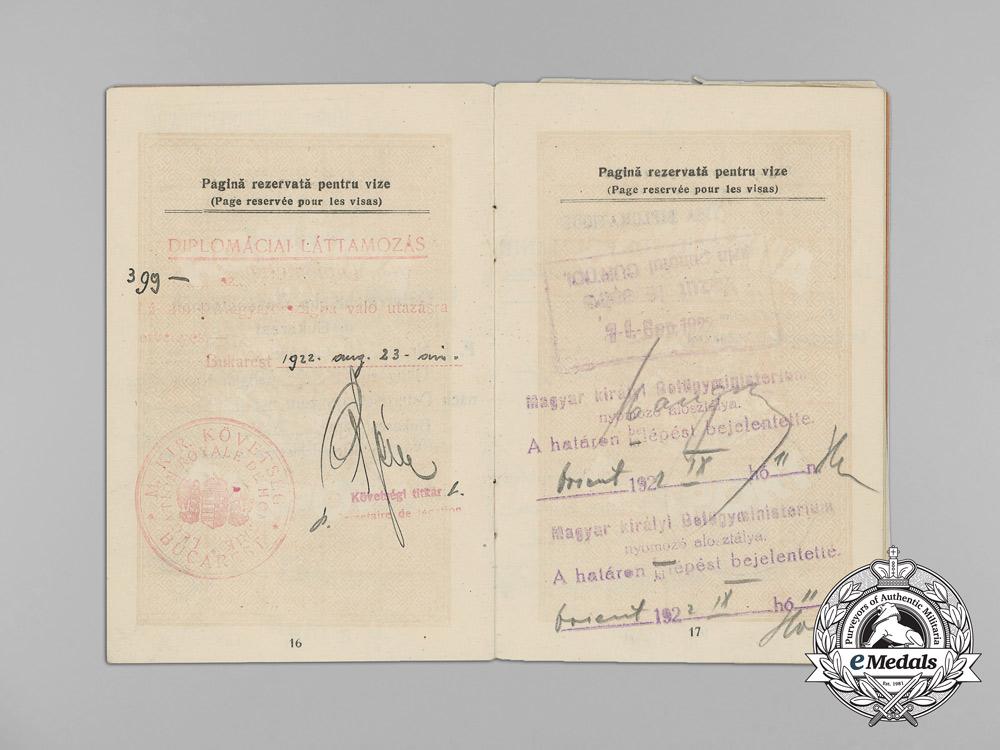
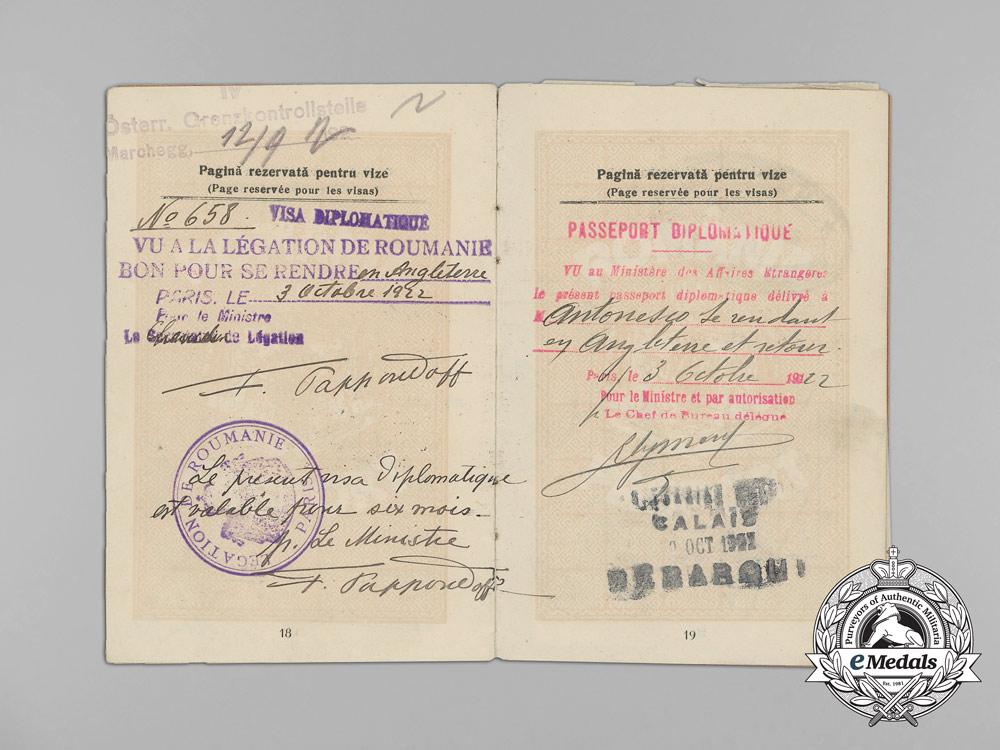
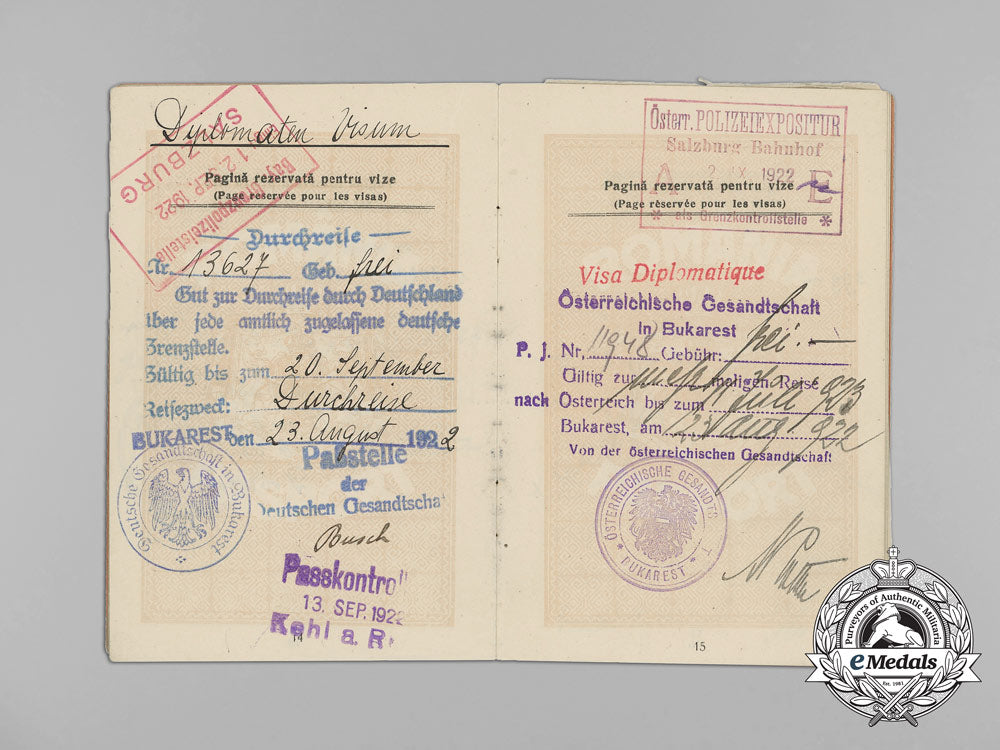
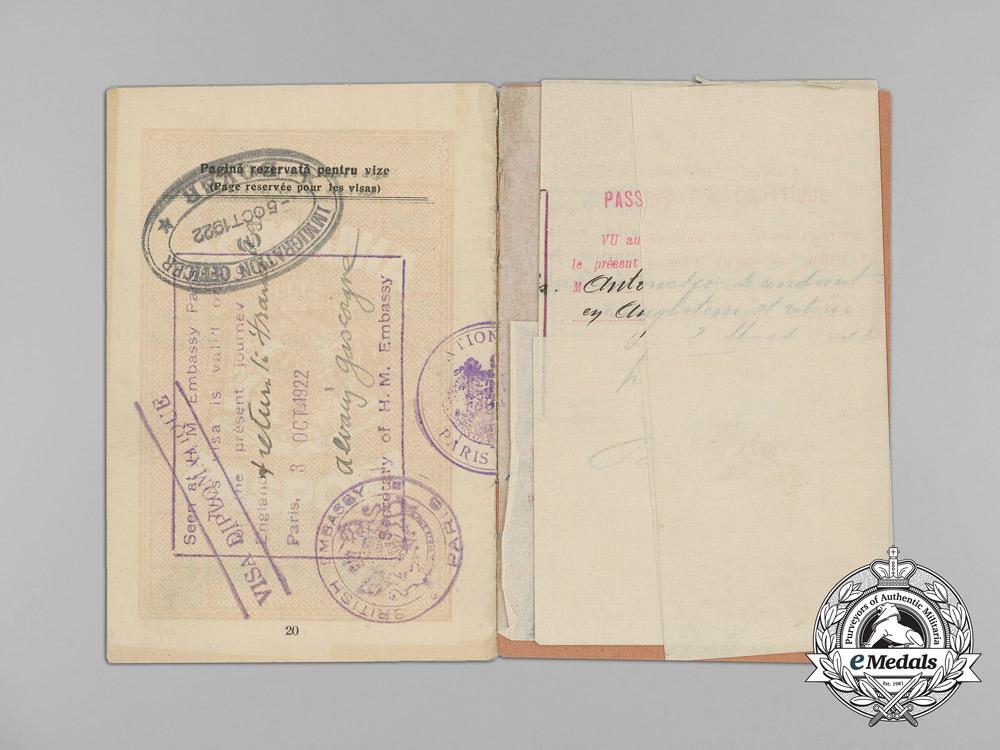
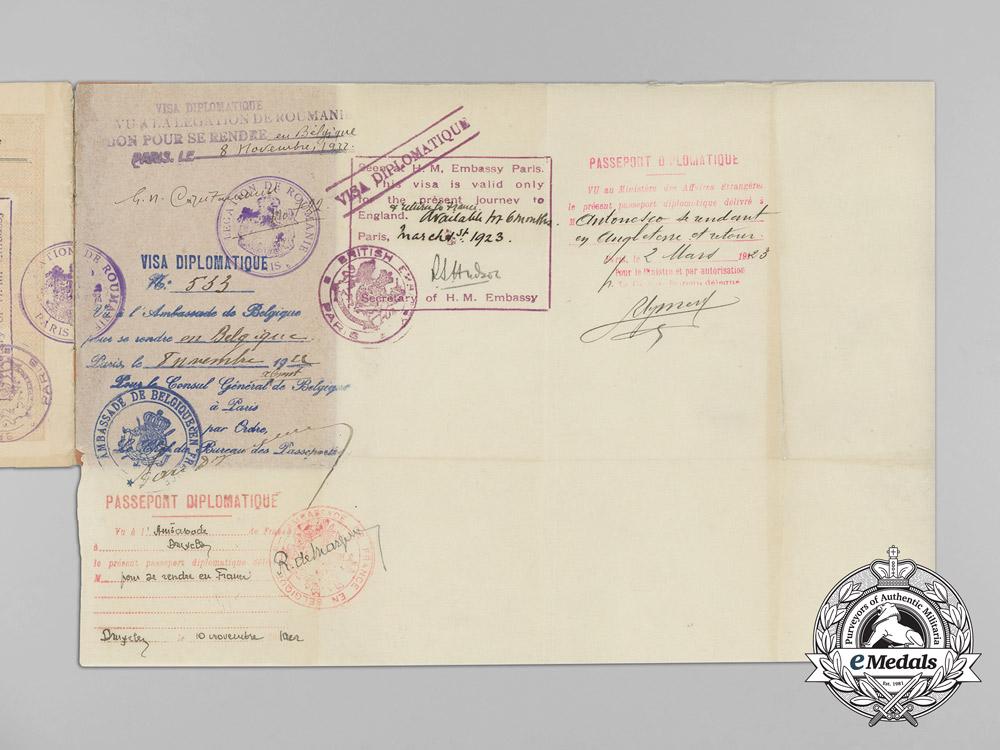
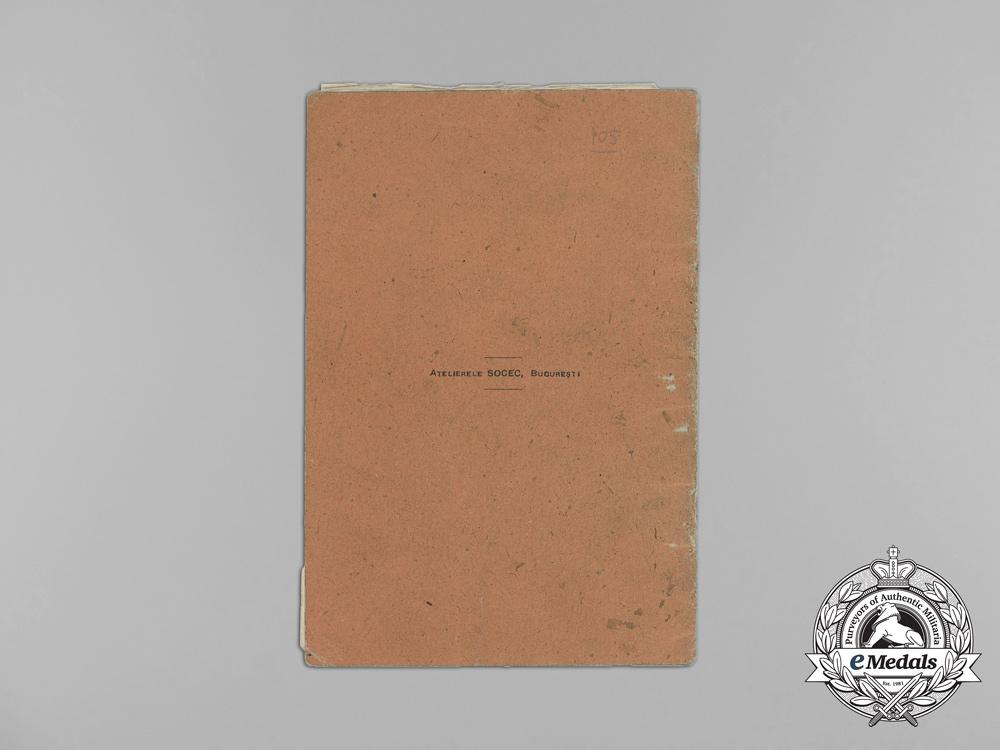
Romania, Kingdom. The Diplomatic Passport Of Ion Antonescu, 1922
Romania, Kingdom. The Diplomatic Passport Of Ion Antonescu, 1922
SKU: ITEM: EU13353
0% Buyer's Premium
Current Bid:
Your Max Bid:
Bid History:
Time Remaining:
Couldn't load pickup availability
Shipping Details
Shipping Details
eMedals offers rapid domestic and international shipping. Orders received prior to 12:00pm (EST) will be shipped on the same business day.* Orders placed on Canadian Federal holidays will be dispatched the subsequent business day. Courier tracking numbers are provided for all shipments. All items purchased from eMedals can be returned for a full monetary refund or merchandise credit, providing the criteria presented in our Terms & Conditions are met. *Please note that the addition of a COA may impact dispatch time.
Shipping Details
eMedals offers rapid domestic and international shipping. Orders received prior to 12:00pm (EST) will be shipped on the same business day.* Orders placed on Canadian Federal holidays will be dispatched the subsequent business day. Courier tracking numbers are provided for all shipments. All items purchased from eMedals can be returned for a full monetary refund or merchandise credit, providing the criteria presented in our Terms & Conditions are met. *Please note that the addition of a COA may impact dispatch time.
Description
Description
eMedals presents the 1922 diplomatic passport of Ion Antonescu, soldier, dictator, and Marshal of Romania during the Second World War.
Passport No. 100898 was issued to Antonescu on July 11, 1922, in Bucharest, Romania. It measures 92x136mm and contains 20 pages with a supernumerary page pasted inside the back cover for additional visas, and a signed photograph of Antonescu on the fourth page. It is stamped with visas for travel to numerous European countries including France, Italy, Switzerland, the Kingdom of Serbs, Croats, and Slovenes (later Yugoslavia), Germany, Austria, Hungary, Great Britain, and Belgium.
Page 1 features the passport number with a handwritten notation identifying the passport as a “Diplomatic Passport.” Page 2 features the passport dedication in Romanian and the signature of Antonescu identifying him as the holder of the passport. Page 3 features the passport dedication in French. Page 4 features a pasted photograph of Antonescu with the official stamp of the Romanian Ministry of Foreign Affairs. Page 5 features the certification of the Minister of Foreign Affairs with the official stamp of the Ministry and the signature of the Minister. It is written in French as follows: “The Royal Minister of Foreign Affairs certifies that the holder of the present passport is the person represented in the photo opposite and that the signature opposite is his.” Page 6 and page 7 feature spaces to list any other persons accompanying the passport holder on their travels. Page 6 appears in Romanian and page 7 appears in French, but neither were filled in. Page 8 features the notice of delivery in Romanian. Page 9 features the notice of delivery in French with the official stamp of the Ministry of Foreign Affairs and the signature of the Minister. Page 10 features an Italian visa with the official stamp of the Legation of Italy in Bucharest and an unidentified signature. Page 11 features a French visa with the official stamp of the Legation of France in Romania and an additional control stamp. Page 12 features a Swiss visa with the official stamp of the Legation of Switzerland in Romania and an unidentified signature. Page 13 features a visa from the Kingdom of Serbs, Croats, and Slovenes with the official stamp of the Legation of the Kingdom of Serbs, Croats, and Slovenes in Romania. It also has a handwritten note with an unidentified signature. Page 14 features a German visa with the official stamp of the Legation of Germany in Bucharest. It also has a stamp showing travel through Salzburg and an additional control stamp. Page 15 features an Austrian visa with the official stamp of the Legation of Austria in Bucharest. It also has a stamp showing travel through Salzburg and an unidentified signature. Page 16 features a Hungarian visa with the official stamp of the Legation of Hungary in Bucharest and an unidentified signature. Page 17 features an unidentified visa with a control stamp. Page 18 features a Romanian visa for travel to England with the official stamp of the Legation of Romania in Paris and an additional control stamp. It is signed twice by the Minister. It also features a handwritten note, which is written in French as follows: “The present diplomatic visa is valid for six months. The Minister.” Page 19 features a visa for travel to and from England with an unidentified signature and a stamp showing travel through Calais. Page 20 features an English visa for travel to France with the official stamps of the British Embassy in Paris and the Legation of Romania in Paris. The is an additional stamp showing travel through Dover.
The pasted page at the back of the passport features a Romanian visa for travel to Belgium with the official stamp of the Legation of Romania in Paris and an unidentified signature, a Belgian visa with the official stamp of the Belgian Embassy in France and an unidentified signature, a Belgian visa for travel to Brussels with the stamp of the Embassy of Belgium in France, an English visa with the stamp of the British Embassy in Paris and an unidentified signature and an additional visa for travel to and from England with an unidentified signature.
Footnote: Ion Antonescu was born in Romania in 1882. He joined the Romanian Army in 1904 as a Second Lieutenant and had achieved the rank of Staff Officer by the outbreak of the Second Balkan War in 1913. He participated in the Second Balkan War and later in the First World War before he commenced his political career in the 1920s. He was accepted into the Romanian military attaché in Paris upon his second nomination in 1922 and went on to serve in the military attachés in London and Brussels in the following year.
In the years leading up to the Second World War, Romania was embroiled in political and social turmoil characterized by economic crises and rising right-wing and anti-semitic movements. It was during this time that Antonescu made decisive moves to consolidate his power and political position in Romania. He was named Chief of the General Staff in 1934, Minister of Defence in 1937, and then leader of Romania following the abdication of King Carol II in 1940.
Upon assuming leadership of Romania, Antonescu formed a government with the Iron Guard, a staunchly nationalist, right-wing, anti-communist and anti-semitic political party with whom he had ties dating back to the previous decade. He would go on to align the nation with the Axis powers and would position Romania as one of the closest allies of Nazi Germany in the Second World War.
Following the end of the Second World War, Antonescu was tried in Romania for war crimes. He was found guilty and was executed on June 1, 1946.
Description
eMedals presents the 1922 diplomatic passport of Ion Antonescu, soldier, dictator, and Marshal of Romania during the Second World War.
Passport No. 100898 was issued to Antonescu on July 11, 1922, in Bucharest, Romania. It measures 92x136mm and contains 20 pages with a supernumerary page pasted inside the back cover for additional visas, and a signed photograph of Antonescu on the fourth page. It is stamped with visas for travel to numerous European countries including France, Italy, Switzerland, the Kingdom of Serbs, Croats, and Slovenes (later Yugoslavia), Germany, Austria, Hungary, Great Britain, and Belgium.
Page 1 features the passport number with a handwritten notation identifying the passport as a “Diplomatic Passport.” Page 2 features the passport dedication in Romanian and the signature of Antonescu identifying him as the holder of the passport. Page 3 features the passport dedication in French. Page 4 features a pasted photograph of Antonescu with the official stamp of the Romanian Ministry of Foreign Affairs. Page 5 features the certification of the Minister of Foreign Affairs with the official stamp of the Ministry and the signature of the Minister. It is written in French as follows: “The Royal Minister of Foreign Affairs certifies that the holder of the present passport is the person represented in the photo opposite and that the signature opposite is his.” Page 6 and page 7 feature spaces to list any other persons accompanying the passport holder on their travels. Page 6 appears in Romanian and page 7 appears in French, but neither were filled in. Page 8 features the notice of delivery in Romanian. Page 9 features the notice of delivery in French with the official stamp of the Ministry of Foreign Affairs and the signature of the Minister. Page 10 features an Italian visa with the official stamp of the Legation of Italy in Bucharest and an unidentified signature. Page 11 features a French visa with the official stamp of the Legation of France in Romania and an additional control stamp. Page 12 features a Swiss visa with the official stamp of the Legation of Switzerland in Romania and an unidentified signature. Page 13 features a visa from the Kingdom of Serbs, Croats, and Slovenes with the official stamp of the Legation of the Kingdom of Serbs, Croats, and Slovenes in Romania. It also has a handwritten note with an unidentified signature. Page 14 features a German visa with the official stamp of the Legation of Germany in Bucharest. It also has a stamp showing travel through Salzburg and an additional control stamp. Page 15 features an Austrian visa with the official stamp of the Legation of Austria in Bucharest. It also has a stamp showing travel through Salzburg and an unidentified signature. Page 16 features a Hungarian visa with the official stamp of the Legation of Hungary in Bucharest and an unidentified signature. Page 17 features an unidentified visa with a control stamp. Page 18 features a Romanian visa for travel to England with the official stamp of the Legation of Romania in Paris and an additional control stamp. It is signed twice by the Minister. It also features a handwritten note, which is written in French as follows: “The present diplomatic visa is valid for six months. The Minister.” Page 19 features a visa for travel to and from England with an unidentified signature and a stamp showing travel through Calais. Page 20 features an English visa for travel to France with the official stamps of the British Embassy in Paris and the Legation of Romania in Paris. The is an additional stamp showing travel through Dover.
The pasted page at the back of the passport features a Romanian visa for travel to Belgium with the official stamp of the Legation of Romania in Paris and an unidentified signature, a Belgian visa with the official stamp of the Belgian Embassy in France and an unidentified signature, a Belgian visa for travel to Brussels with the stamp of the Embassy of Belgium in France, an English visa with the stamp of the British Embassy in Paris and an unidentified signature and an additional visa for travel to and from England with an unidentified signature.
Footnote: Ion Antonescu was born in Romania in 1882. He joined the Romanian Army in 1904 as a Second Lieutenant and had achieved the rank of Staff Officer by the outbreak of the Second Balkan War in 1913. He participated in the Second Balkan War and later in the First World War before he commenced his political career in the 1920s. He was accepted into the Romanian military attaché in Paris upon his second nomination in 1922 and went on to serve in the military attachés in London and Brussels in the following year.
In the years leading up to the Second World War, Romania was embroiled in political and social turmoil characterized by economic crises and rising right-wing and anti-semitic movements. It was during this time that Antonescu made decisive moves to consolidate his power and political position in Romania. He was named Chief of the General Staff in 1934, Minister of Defence in 1937, and then leader of Romania following the abdication of King Carol II in 1940.
Upon assuming leadership of Romania, Antonescu formed a government with the Iron Guard, a staunchly nationalist, right-wing, anti-communist and anti-semitic political party with whom he had ties dating back to the previous decade. He would go on to align the nation with the Axis powers and would position Romania as one of the closest allies of Nazi Germany in the Second World War.
Following the end of the Second World War, Antonescu was tried in Romania for war crimes. He was found guilty and was executed on June 1, 1946.















You May Also Like
Germany, Third Reich. A Mixed Lot of Tyrolean Marksmanship Badges
G52930
Germany, SS. An Estonian Waffen-SS Volunteer’s Sleeve Shield
G50381
Germany, SS. A Waffen-SS Sturmmann Sleeve Insignia
G52846
Germany, Third Reich; Slovakia, First Republic. A Mixed Lot of Wartime Postcards
G52905
Germany, Third Reich. A Pair of Tyrolean Marksmanship Badges
G52981
-
Germany, Third Reich. A Mixed Lot of Tyrolean Marksmanship Badges
G52930
Add to CartRegular price $135 USDRegular price $0 USD Sale price $135 USDUnit price / per -
Germany, SS. An Estonian Waffen-SS Volunteer’s Sleeve Shield
G50381
Add to CartRegular price $150 USDRegular price $0 USD Sale price $150 USDUnit price / per -
Germany, SS. A Waffen-SS Sturmmann Sleeve Insignia
G52846
Add to CartRegular price $135 USDRegular price $0 USD Sale price $135 USDUnit price / per -
Germany, Third Reich; Slovakia, First Republic. A Mixed Lot of Wartime Postcards
G52905
Add to CartRegular price $135 USDRegular price $0 USD Sale price $135 USDUnit price / per -
Germany, Third Reich. A Pair of Tyrolean Marksmanship Badges
G52981
Add to CartRegular price $135 USDRegular price $0 USD Sale price $135 USDUnit price / per
Do you have a similar item you are interested in selling?
Please complete the form and our client care representatives will contact you.
Sell Item


































